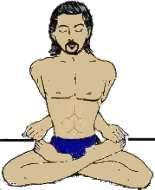| |
 |
apid |
Just what you need to know! |
| eview |
|

Basic Facts about the Yoga Posture (Asana)
The Restrained Lotus Posture (whose original Indian name is Baddha Padmasana) in Yoga is suitable for strengthening the body and improving health. Although it is a variation of the Lotus Posture (Padmasana or Kamalasana), it is not intended for meditation (Dhyana) because of the difficulty of remaining in the final position for long.
Note that Baddha means Restrained, whereas Padma (or Kamal) means Lotus. The posture gets its basic name (Padmasana) because the person performing it resembles a Lotus. The name Baddha signifies that the body is restrained by the locking together of the crossed hands (at the back) and the crossed legs (in the front).
Stepwise Technique 
- Sit on the ground with your head and spine erect. Extend your legs forward such that your knees and heels are placed together. With the help of your hands, place your left foot on the right thigh and then your right foot on the left thigh. Try to touch both knees to the ground.
- Swiftly and smoothly move your right hand behind your back toward the left hip to hold your right big toe in the right palm or index finger. Similarly, swiftly and smoothly move your left hand behind your back toward the right hip to hold the left big toe in your left palm or index finger.
- Remain in this final posture with your eyes closed (or open) for about 1-2 minutes (in the early stages) or your breakpoint*. Increase this time gradually to about 5 minutes.
- Repeat the above steps with your right foot first placed on the left thigh and your left foot then placed on the right thigh. This will ensure that both legs are built uniformly.
Tips and Comments
- When your left foot is placed on the right thigh first and then your right foot on the left thigh, get hold of your right big toe first and subsequently your left big toe. When your right foot is placed on the left thigh first, get hold of your left big toe first. The simple rule to remember is to first get hold of the upper big toe.
- In the early stages, you may be able to place only one foot on the thigh; however, regular practice of the Lotus Posture (Padmasana) will make the process of placing both feet on the thighs easier. Also, if you initially experience difficulty in holding your toes, bend slightly forward and move the shoulders back while swinging your arms back to hold the toes. Note that this is a relatively difficult asana to perform.
- After great practice in Baddha Padmasana, you may swing your head backwards and breathe in deeply. Then, breathe out and swing forward to kiss the floor still holding the toes. This pose is called Yoga Mudrasana and may help awaken the Kundalini. Rather than kiss the floor, you may alternately kiss the left and right knees.
- *Breakpoint is the time upto which you can comfortably remain in a yoga posture. It varies from individual to individual depending on one's fitness, age and will power.
Potential Benefits of the Yoga Posture (Asana)
- The Restrained Lotus Posture (Baddha Padmasana) is a variation of the Lotus Posture (Padmasana). Therefore, it includes the benefits of the Lotus Posture.
- The yoga pose also aids in strengthening the heart, lungs, shoulders and spine.
- The yoga posture strengthens the joints of the legs. Since the body weight is supported by the knees and ankles, this yoga pose helps decrease pain in them.
- The yoga posture helps to increase the positive pressure on the abdominal region. Since the abdominal wall becomes healthy and strong, the yoga posture aids in treating gastric disorders including stomachaches, constipation and indigestion.
Disclaimer : Syvum makes no representations or warranties of any kind, express or implied, as to the correctness of the content as well as the accuracy and use of the information regarding the practice of Yoga. It is strongly advised that you consult your physician before engaging in any physical activities. The information herein is not intended to substitute professional medical opinion or qualified Yoga instructors' opinion. To the full extent permissible by applicable law, Syvum disclaims all warranties, express or implied, including but not limited to, implied warranties and fitness for a particular purpose. Syvum will not be liable for any damages of any kind arising from the use of the information regarding the practice of Yoga, including but not limited to direct, indirect, incidental, punitive and consequential damages.
|
|

